

Arabidopsis thaliana. Arabidopsis thaliana (/ərˌæbɨˈdɒpsɪsˌθɑːliˈɑːnə/ thale cress, mouse-ear cress or arabidopsis) is a small flowering plant native to Eurasia.[1][2][3][4] A winter annual with a relatively short life cycle, Arabidopsis is a popular model organism in plant biology and genetics.
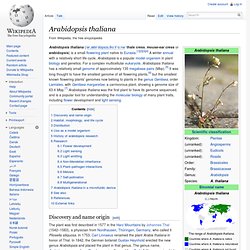
For a complex multicellular eukaryote, Arabidopsis thaliana has a relatively small genome of approximately 135 megabase pairs (Mbp).[5] It was long thought to have the smallest genome of all flowering plants,[6] but the smallest known flowering plants' genomes now belong to plants in the genus Genlisea, order Lamiales, with Genlisea margaretae, a carnivorous plant, showing a genome size of 63.4 Mbp.[7] Arabidopsis thaliana was the first plant to have its genome sequenced, and is a popular tool for understanding the molecular biology of many plant traits, including flower development and light sensing.
Coronopus. Coronopus is a genus of plants in the mustard family known commonly as swinecress or wartcress.
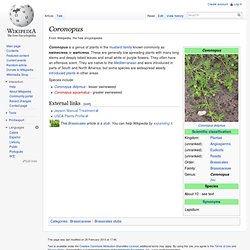
These are generally low spreading plants with many long stems and deeply lobed leaves and small white or purple flowers. They often have an offensive scent. They are native to the Mediterranean and were introduced in parts of South and North America, but some species are widespread weedy introduced plants in other areas. Species include: Coronopus didymus - lesser swineweedCoronopus squamatus - greater swineweed. Cress. Cress may refer to: Plants[edit] Plants cultivated for their edible leaves: Garden cress, a leafy vegetableland cress, a biennial herbwatercress, a perennial Other plants not usually cultivated or consumed:

Cardamine bulbosa. Barbarea verna. Whitetop. Lepidium draba (whitetop or hoary cress) is native to western Asia and eastern Europe and is an invasive species in North America, introduced by contaminated seeds in the early 1900s.
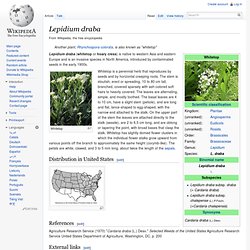
Whitetop Whitetop is a perennial herb that reproduces by seeds and by horizontal creeping roots. The stem is stoutish, erect or spreading, 10 to 80 cm tall, branched, covered sparsely with ash-colored soft hairs to heavily covered. Garden cress. This annual plant can reach a height of 60 cm (~24 inches), with many branches on the upper part.
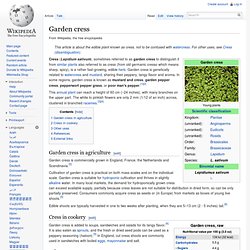
The white to pinkish flowers are only 2 mm (1/12 of an inch) across, clustered in branched racemes.[3][4] Leavenworthia stylosa. Leavenworthia stylosa is a species of flowering plant in the mustard family known by the common names Cedar Gladecress or Long-styled Gladecress.

It is found only in the Central Basin of Tennessee, where it grows in cedar glades, ditches, and low-lying fields.[2] L. stylosa typically blooms from March to May.[2][3] The flowers are about 1 inch wide and are white or yellow in color with a yellow center. The tips of the petals are notched. Yellow varieties are found more commonly north of Nashville, while white varieties are found more commonly south.[2] Yellow variation Jump up ^ "Leavenworthia stylosa". Cardamine hirsuta. This plant grows best in damp, recently disturbed soil.
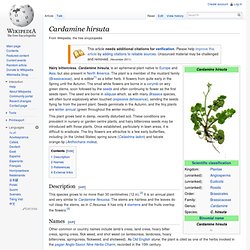
These conditions are prevalent in nursery or garden centre plants, and hairy bittercress seeds may be introduced with those plants. Once established, particularly in lawn areas, it is difficult to eradicate. The tiny flowers are attractive to a few early butterflies, including (in the United States) spring azure (Celastrina ladon) and falcate orange-tip (Anthocharis midea). Description[edit] This species grows to no more than 30 centimetres (12 in).[2] It is an annual plant and very similar to Cardamine flexuosa.
Arabis alpina. A. alpina is believed to have originated in Asia Minor about 2 million years ago.

From there it migrated twice into East Africa (500,000 years ago) where it grows today on the high East African mountains in the ericaceous belt. Another migration route led A. alpina into Europe which was then colonised periglacially. Watercress. The hollow stems of watercress are floating, and the leaves are pinnately compound.
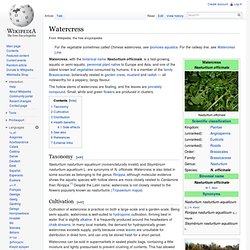
Small, white and green flowers are produced in clusters. Taxonomy[edit] Nasturtium nasturtium-aquaticum (nomenclaturally invalid) and Sisymbrium nasturtium-aquaticum L. are synonyms of N. officinale. Watercress is also listed in some sources as belonging to the genus Rorippa, although molecular evidence shows the aquatic species with hollow stems are more closely related to Cardamine than Rorippa.[1] Despite the Latin name, watercress is not closely related to the flowers popularly known as nasturtiums (Tropaeolum majus). Cultivation[edit] Cultivation of watercress is practical on both a large-scale and a garden-scale. Watercress can be sold in supermarkets in sealed plastic bags, containing a little moisture and lightly pressurised to prevent crushing of contents. Also sold as sprouts, the edible shoots are harvested days after germination. Rockcress. Rockcress is a common name used for several similar genera of flowering plants in the family Brassicaceae:

Lepidium. Lepidium is a genus of plants in the mustard family, Brassicaceae. Rorippa. Rorippa is a flowering plant genus in the mustard family, Brassicaceae, native to Europe through central Asia, Africa, and North America. Rorippa species are annual to perennial herbs, usually with yellow flowers and a peppery flavour. They are known commonly as yellowcresses. Barbarea. Barbarea (winter cress or yellow rocket) is a genus of about 22 species of flowering plants in the family Brassicaceae, native to temperate regions of the Northern Hemisphere, with the highest species diversity in southern Europe and southwest Asia. They are small herbaceous biennial or perennial plants with dark green, deeply lobed leaves and yellow flowers with four petals. Selected species[edit] Uses[edit] They grow quickly into dandelion-like rosettes of edible, cress-like foliage.